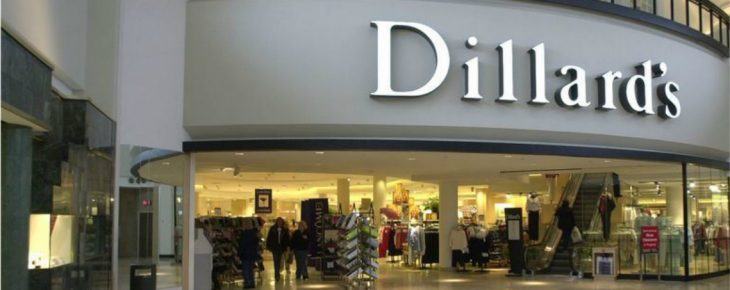Dillard’s pares 2Q losses as brick-and-mortar retailers slide on Wall Street
by August 16, 2018 8:35 am 407 views

Dillard’s Inc. on Thursday (Aug. 16) tidied up losses from a year ago and easily beat Wall Street expectations as the Little Rock department store chain and other retailers look to gain momentum in the second half of 2018 as stronger consumer spending is expected to pick up heading into the all-important holiday season.
For the 13-week period ended Aug. 4, the upscale Arkansas retailer reported a net loss of $2.9 million, or 10 cents per share, compared to a net loss of $17.1 million, or 58 cents per share, in the same period of 2017. Dillard’s second quarter sales rose slightly to nearly $1.47 billion, up 2.8% compared to $1.43 billion a year ago. Wall Street had expected the company to report a second quarter loss of 44 cents on sales of $1.48 billion, according to Thomson Reuters.
“While we are not happy with a loss for the quarter, our 32% improvement in year-to-date pretax income is a positive,” Dillard’s CEO William Dillard said in the company’s earnings report ahead of Thursday’s opening bell. “We believe this reflects the continued strength of our customers and their interest in our merchandise selections, and it is encouraging as we head into the important back half of the year.”
In Thursday’s pre-market activity, Dillard’s stock was slightly down 53 cents to $82.98 as brick-and-mortar retailers fell broadly in Wednesday’s sessions on Wall Street after industry bellwether Macy’s Inc. released its second quarter financials. Over the past 52 weeks, the Arkansas retailer’s shares have traded between $49.91 and $98.75.
Companywide, Dillard’s total merchandise sales were nearly $1.41 billion, up 1.4% from $1.39 billion in the same quarter of 2017. Same stores sales, a key metric of the retail industry, rose 1% as sales of men’s’ apparel and accessories and juniors’ and children’s apparel trended as elementary students and teenagers head back to school.
Sales in home and furniture and cosmetics were consistent were flat while sales in ladies’ accessories and lingerie were slightly below trend. Below trend performances were also noted in shoes and ladies’ apparel.
Year-over-year gross margin from retail operations, which excludes the company’s CDI construction business, improved 163 basis points on sales for the 13 weeks ended Aug. 4, primarily due to a decline in department store markdowns. Consolidated gross margin the 13-week period improved 127 basis points of sales compared to year ago, while inventory rose 5% in the second quarter from a year ago.
Dillard’s operating expenses were nearly $400 million in the second quarter, which is 27.8% of total sales. A year ago, Dillard’s selling, general and administration costs were $401.6 million, which represented 28.2% of sales. Company officials said the $8.6 million spike in operating expenses was primarily due to higher costs for payroll outsourcing services.
The Little Rock retailer said it purchased nearly 39,400 of the company’s Class A common stock shares at a price of $3.1 million under the company’s current $500 million stock buyback program. Year-to-date, the company has purchased 518,000 shares at $39.8 million under the share repurchase program. Company officials said the Arkansas upscale department store owner also paid the remaining $161 million principal on unsecured debt that matured on Aug. 1.
On Wednesday, Dillard’s rival and industry leader Macy’s Inc. reported second quarter earnings of $166 million on sales of nearly $5.7 billion. Both of those numbers easily beat Wall Street expectations, but shares of the Cincinnati, Ohio-based upscale retailer still fell more than 15%.
Ahead of the quarterly financial reports for the top U.S. clothiers, the NRF reported that July retail sales were up 0.4% seasonally adjusted from June and increased 4.9% unadjusted year-over-year, giving the industry a solid kickoff for the third quarter as consumers continued to spend despite concerns about the growing trade war.
“(These) numbers mirror the economy, which is in very good shape,” said NRF Chief Economist Jack Kleinhenz, citing consumer confidence, a strengthening labor market and more after-tax dollars in household wallets thanks to tax reform. “Consumer fundamentals remain healthy and continue to provide wherewithal for consumers to drive domestic economic growth.”
Kleinhenz, however, issued a warning that the Trump administration’s trade war is creating uncertainty for the retail trade. “Consumer spending is the backbone of the current economic expansion but the fly in the ointment is uncertainty regarding tariffs. If they escalate, they will no doubt weigh on confidence and household spending,” he said.
Despite the two-day sell-off on Wall Street, Macy’s upgraded its yearly earnings forecast from $3.95 to $4.15 per share and said it still expects comparable sales to decline by 2% to 2.3% for the full year. Dillard’s does not generally provide quarterly or yearly forecast for same-store sales, earnings or revenue growth. Dillard’s operates 268 Dillard’s locations and 25 clearance centers spanning 29 states.
